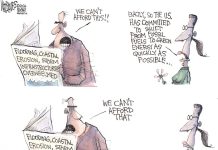The Houston Chronicle
In his 1979 book about the pilots who would become the first Project Mercury astronauts selected for the NASA space program, author Tom Wolfe introduced an archetype for the sort of courage and competence that it would take to get America to the moon.
It was what Wolfe called “the right stuff,” the substance of uniquely American heroes.
Travelers heard it in the folksy voice of the pilot “that tells you, as the airliner is caught in thunderheads and goes bolting up and down a thousand feet at a single gulp, to check your seat belts because ‘it might get a little choppy.’”
An audience on the verge of panic and terror is somehow reassured by the laconic, aw-shucks monologue of someone who sounds as though he has never faced a challenge he couldn’t overcome with skill, knowledge and that dash of daring that would seem arrogant if it weren’t saving lives.
“It was,” Wolfe wrote, “the drawl of the most righteous of all the possessors of the right stuff: Chuck Yeager.”
Yeager’s death on Dec. 7 in Los Angeles at the age of 97 is yet another passing from what has become known as the Greatest Generation, the men and women who fought in World War II and came home to help build the nation into an economic and technological force that would eventually extend into outer space.
A fighter ace who shot down five German planes in a single day and 13 overall during the war, Yeager was already something of a legend when he became the first person to fly faster than the speed of sound in 1947.
As an Air Force captain, he piloted a Bell Aircraft X-1 to a speed of 700 mph, breaking the sound barrier at a time when some feared the shock waves would destroy the aircraft.
The accomplishment would lead the way to other major aeronautical achievements, including the space program and the lunar landing.
A West Virginia native who joined the Air Force with only a high school education, Yeager epitomized the American ideal of succeeding through grit and determination.
“All I know is I worked my tail off learning to learn how to fly, and worked hard at it all the way,” he wrote in his 1985 memoir. “If there is such a thing as the right stuff in piloting, then it is experience. The secret to my success was that somehow I always managed to live to fly another day.”
It is that combination of confidence, calm and humility that Americans so admire from heroes such as Apollo 13 Commander Jim Lovell bringing his crew back from disaster in space or Chesley “Sully” Sullenberger ditching a crippled US Airways Flight 1549 in the Hudson River with all 155 on board surviving.
Yeager set the standard for all who followed.
“In an age of media-made heroes, he is the real deal,” Edwards Air Force Base historian Jim Young said at the unveiling of a bronze statue of Yeager in August 2006.
As Americans face a harsh winter of the COVID-19 pandemic, it would be good to think of those humble heroes who embraced the dangers and sacrifices to take on the task of getting things done to “fly another day.” That’s the right stuff.
Send comments to [email protected].




